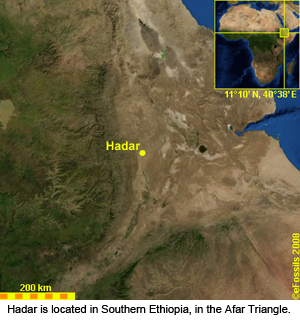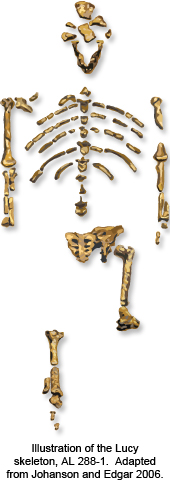 On November 24, 1974, Donald Johanson and his student Tom Gray were surveying a site named Hadar in the Afar region of Ethiopia, East Africa (shown right) when they noticed a bone jutting out of the ground. They began work to uncover the bone and found many more bone fragments, which turned out to be a remarkably complete early hominin skeleton (illustrated below). Officially, the skeleton is designated AL 288-1, denoting that it was discovered at (A)far (L)ocality 288. The skeleton was nicknamed "Lucy" after the Beatles’ song, "Lucy in the Sky with Diamonds" that was playing while the research crew celebrated the Lucy’s discovery. In Amharic, an Ethiopian language, she is affectionately referred to as "Dinquinesh," meaning "wonderful thing.1"
On November 24, 1974, Donald Johanson and his student Tom Gray were surveying a site named Hadar in the Afar region of Ethiopia, East Africa (shown right) when they noticed a bone jutting out of the ground. They began work to uncover the bone and found many more bone fragments, which turned out to be a remarkably complete early hominin skeleton (illustrated below). Officially, the skeleton is designated AL 288-1, denoting that it was discovered at (A)far (L)ocality 288. The skeleton was nicknamed "Lucy" after the Beatles’ song, "Lucy in the Sky with Diamonds" that was playing while the research crew celebrated the Lucy’s discovery. In Amharic, an Ethiopian language, she is affectionately referred to as "Dinquinesh," meaning "wonderful thing.1"
 Lucy was allocated to the species, Australopithecus afarensis, meaning "African southern ape from the Afar region." However, Lucy was not the first A. afarensis discovery. An articulated knee joint dating to 3.4 million years ago (Ma) was discovered a year earlier in 1973, but it was not properly identified as A. afarensis until 1979. Still, Lucy’s discovery eclipsed nearly all earlier findings because of the extraordinary completeness of Lucy’s skeleton, making her one of the most important paleoanthropological findings of our time. Roughly 40% of Lucy’s skeleton is accounted for (hands and feet excluded), including cranial material such as fragments of the cranial vault, face, and jaw. Postcranial material includes parts of the shoulder, spine, and pelvis. Much of the limbs bones are also represented (upper arm and forearm fragments, a carpal and finger bone, a partial tibia and nearly complete femur)1.
Lucy was allocated to the species, Australopithecus afarensis, meaning "African southern ape from the Afar region." However, Lucy was not the first A. afarensis discovery. An articulated knee joint dating to 3.4 million years ago (Ma) was discovered a year earlier in 1973, but it was not properly identified as A. afarensis until 1979. Still, Lucy’s discovery eclipsed nearly all earlier findings because of the extraordinary completeness of Lucy’s skeleton, making her one of the most important paleoanthropological findings of our time. Roughly 40% of Lucy’s skeleton is accounted for (hands and feet excluded), including cranial material such as fragments of the cranial vault, face, and jaw. Postcranial material includes parts of the shoulder, spine, and pelvis. Much of the limbs bones are also represented (upper arm and forearm fragments, a carpal and finger bone, a partial tibia and nearly complete femur)1.
The preservation of so much of Lucy’s skeleton has allowed researchers to study a number of aspects of her anatomy, about how she moved in her environment (locomotion), what she ate (diet), and even to hypothesize about how she is related to modern humans.
eFossils is a collaborative website in which users can explore important fossil localities and browse the fossil digital library. If you have any problems using this site or have any other questions, please feel free to contact us.
Funding for eFossils was provided by the Longhorn Innovation Fund for Technology (LIFT) Award from the Research & Educational Technology Committee (R&E) of the IT governance structure at The University of Texas at Austin.
